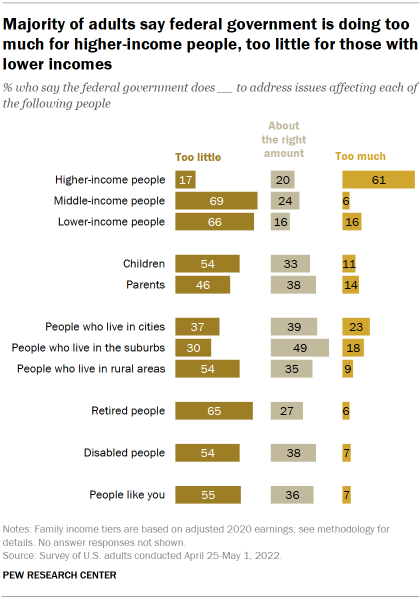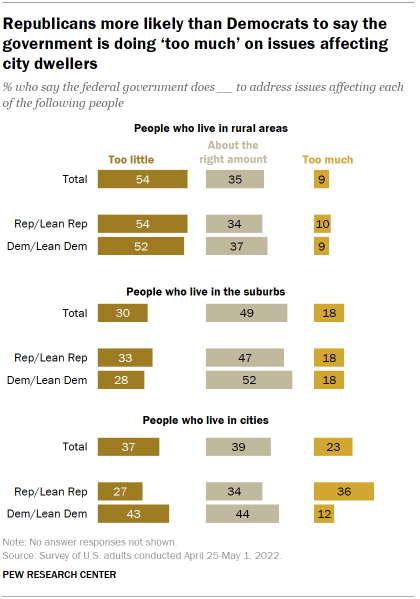
There has been little recent change in the public’s views of whether government generally should do more to solve problems, or whether it is doing too many things better left to businesses and individuals.
Currently, a majority of adults (53%) say that the government should do more to solve problems; a nearly identical share said this in 2021 (55%). Today, 45% say the government is doing too many things better left to businesses and individuals.
There consistently have been wide partisan differences in these views. Democrats are about three times as likely as Republicans to say that government should do more to solve problems (76% vs. 25%).
While Democrats are slightly less likely to say the government should do more to solve problems than they were in 2021, Republican views are virtually unchanged.
There are also sizable differences by race and ethnicity, as well as by age.

While large majorities of Black (72%), Asian (68%) and Hispanic (65%) respondents say that government should do more, about half of White adults (52%) say that the government is doing too many things better left to businesses and individuals.
Younger adults are more likely than older adults to say the government should do more.
Majorities of those ages 18 to 29 (63%) and 30 to 49 (59%) say that government should do more; about half of adults ages 50 to 64 and four-in-ten over the age of 65 say the same.
Groups and the federal government
When it comes to addressing the needs of various people in the country today, a majority of adults say the federal government is doing too much for higher-income adults – and too little for those with lower and middle incomes.
A majority of the public says the federal government is doing too little to address issues affecting middle-income (69%) and lower-income people (66%). Conversely, about six-in-ten (61%) say the government is doing too much for higher-income adults.

A similarly large majority (65%) also says the government is doing too little to address the needs of retired people.
For the other groups asked about in the survey, views are more mixed. For example, the public overall is more likely to say that the government is doing too little for people who live in rural areas (54%), but is less likely to say this about those who live in cities (37%) or suburbs (30%).
More than half of U.S. adults (55%) say that the government is doing too little to address issues affecting “people like you.” By comparison, 36% say the government is doing about the right amount to address these problems, while just 7% say it is doing too much.
Though there is bipartisan agreement about the level of assistance the government is providing some groups, there are sizable gaps in views of its support of other groups – including lower-income people, children and disabled people.

Republicans and Democrats are fairly aligned in views of how much the government is doing for middle- and higher-income adults. However, Democrats are far more likely than Republicans to say the government is doing too little to address the needs of lower-income people (79% vs. 50%).
There are also significant gaps in views of children and parents. Compared with Republicans, Democrats are more likely to say the government is doing too little for each of these groups – 63% of Democrats say the government is doing too little for children, compared with 44% of Republicans who say this. Republicans are far more likely than Democrats to say the government is doing too much for children (19% vs. 5%), while about a third in each party say the government is providing about the right amount of assistance.
And while about half of Democrats (49%) say too little is being done for parents, about four-in-ten Republicans (41%) say the same. Republicans are about three times as likely as Democrats to say the government is doing too much in addressing issues that affect parents (23% vs. 7%).
Democrats are also considerably more likely than Republicans to say too little is done for people with disabilities (60% vs. 45%). More than four-in-ten Republicans (44%) say about the right amount is being done to address this group’s needs, compared with 34% of Democrats who say this.

While similar majorities of Republicans and Democrats say the government is doing too little to address issues affecting middle-income adults, there are sizeable partisan gaps in views about how the government is addressing the needs of lower-income and higher-income adults.
About eight-in-ten Democrats (79%) say the government is doing too little to address the needs of lower-income people; this compares with half of Republicans who say the same. Three-in-ten Republicans say the government is doing too much for low-income adults, while 19% say it is doing about the right amount.
There is also a sizable gap in views of what the federal government is doing for higher-income people. Democrats are far more likely than Republicans to say the government is doing too much to address issues facing high-income adults (69% vs. 53%, respectively). Republicans are much more likely than Democrats to say the government is doing about the right amount (28% vs. 12%).
By and large, Republicans and Democrats have similar views about how the federal government is doing addressing issues facing suburban and rural people. But there is a wide partisan gap in views of those who live in urban areas.

About half of adults in each partisan group say too little is done for people who live in rural areas; smaller shares say the government is doing about the right amount to address issues affecting adults in rural communities.
Republicans and Democrats also hold similar views about suburbanites: About half of adults in each party say the government is doing about the right amount to address the needs of people who live in suburbs.
But there is a wider gap in views of government attention to people who live in cities. Democrats are considerably more likely than Republicans to say too little is done for city dwellers (43% vs. 27%). In contrast, Republicans are three times as likely as Democrats to say the government is doing too much for those who live in cities.
Democrats more likely than Republicans to say government aid to poor does more good than harm
Overall, a 54% majority of Americans say that government aid to the poor “does more good than harm because people can’t get out of poverty until their basic needs are met.” A smaller share (45%) says that government aid to the poor “does more harm than good by making people too dependent on government assistance.”

Seven-in-ten Black adults say that government aid does more good than harm, compared with about half of Hispanics (53%) and half of White adults who say the same thing.
A large majority of adults ages 18 to 29 (69%) say that government aid does more good than harm, more than any other age group.
About half of adults ages 30 to 49 and 50 to 64 (53% each) say that government aid to the poor does more good than harm, while a small majority of those over the age of 65 say that government aid does more harm than good.
Lower-income adults are more likely to have favorable views of government aid to the poor: About two-thirds of this group say that this aid does more good than harm, compared with about half of middle- (51%) and upper-income (48%) adults.
There are also ideological differences within each party with moderates in each party expressing somewhat more mixed views than those who are more conservative or liberal. Moderate and liberal Republicans are nearly twice as likely as conservative Republicans to say that aid to the poor does more good than harm (41% vs. 20%). Among Democrats, a larger majority of liberals (85%) than moderates and conservatives (67%) have a positive view of the impact of aid to the poor.
Among Republicans, there are considerable differences in views of government aid to the poor by age and income.

Republicans under the age of 50 are about twice as likely as those 50 and older to say that government aid does more good than harm (38% vs. 20%).
About half of lower-income Republicans (52%) say that government aid to the poor does more good than harm, compared with much smaller shares of middle- (23%) and upper-income (13%) Republicans who say this.
There are no substantial differences among Democrats by age or income.
Most say religion should be kept separate from government policy

Though the vast majority of adults say religion should be kept separate from government policies (73%), there are sizable differences in these views by partisanship and religious affiliation. There are also more modest differences by race and ethnicity, and by age.
While large majorities of adults across racial and ethnic groups say that religion should be kept out of government policies, Black adults are slightly more likely than others to say the government should support religious values and beliefs: About a third of Black adults say this, compared with about two-in-ten adults of other racial and ethnic groups.
And while majorities of both Republicans (61%) and Democrats (84%) say religion should be separate from government policies, Republicans are more than twice as likely as Democrats to say government policies should support religious values and beliefs (38% vs. 16%). Among Republicans, those who are religiously affiliated – as well as older Republicans – are particularly likely to say this.
White evangelical Protestants stand out for their views on the relationship between government and religion: About half say government policies should promote religious values and beliefs. This compares with a smaller share of White non-evangelicals (25%) and Black Protestants (39%) who say the same. Religiously unaffiliated adults overwhelmingly say that the U.S. government should not promote religious values (91%).




